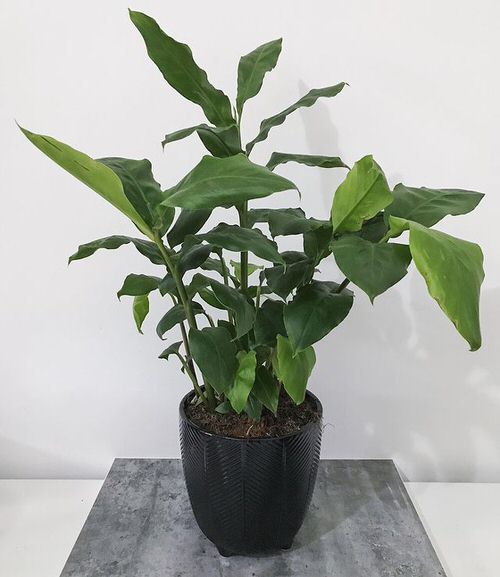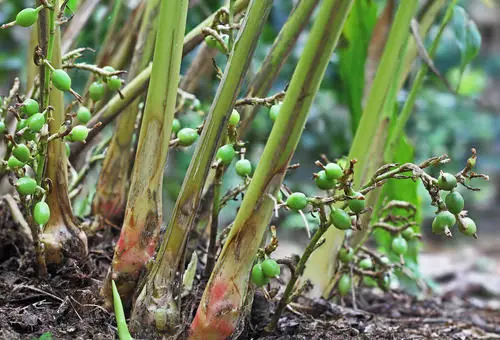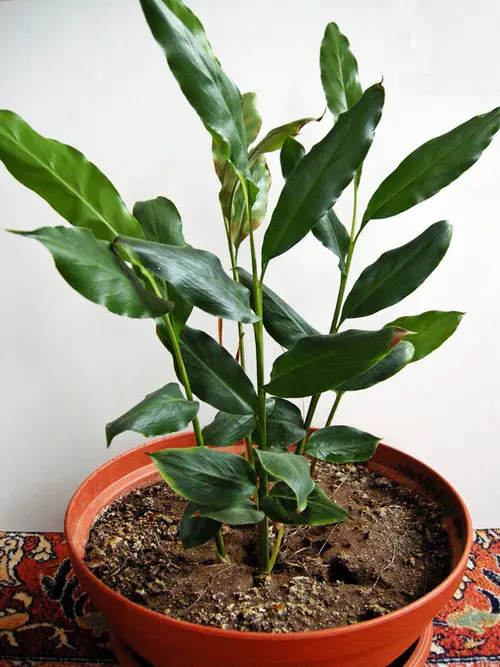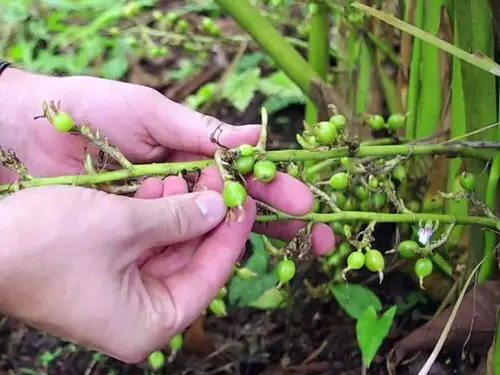Want a spice garden of your own? Learn How to Grow Cardamom Plant in a Pot and get the spicy organic flavor right at your fingertips!

An organic vegetable garden sounds like a healthy practice, but how about trying out spices — that too in a pot? Read on to learn How to Grow Cardamom Plant in Pot!
Learn all about growing fenugreek in pots here
How Does a Cardamom Plant Look Like?
Cardamom shows off sword-like leafy shoots from a single green stem resembling the big ginger plant. The plant grows up to a height of 6 to 15 feet, holding pretty tiny white or yellow flowers with purple veins. The edible spice comes in small green, white, or dark brown seed pods—pyramidic in shape with a papery outer covering.
Native to the moist forests of Southern India, the cardamom is a member of the Zingiberaceae family. The plant thrives in warm and humid climates resembling USDA Zones 9-11.
Like other members of the ginger family, the spice is a treasure of health benefits that include cancer-fighting and anti-inflammatory properties, healing ulcers, and controlling blood pressure and blood sugar levels, among others.
Botanical Name: Elettaria cardamomum
Best Cardamom Plant Varieties
The cardamom plant comes in 3 primary varieties that include:
- Malabar: Native variety of Kerala, India, and grows horizontally along the ground. It grows black seeds.
- Mysore: Native to Karnataka, India. Grows floral racemes vertically. It is a green variety.
- Vazhuka: A hybrid between Malabar and Mysore varieties that shapes between horizontal and vertical rows. It is also a green variety.
The best news for urban gardeners is that all the varieties can easily be grown in pots!
Check out some clever ideas to use spices in the garden here
Choosing a Pot
The best pot size to grow a cardamom plant is 12-14 inches. As the plant doesn’t appreciate transplanting, it would be a good idea to grow it in a relatively large container, to give it enough room for future development.
Just make sure it has a drainage hole at the bottom.
How to Grow Cardamom Plant in a Pot?

Cardamom plants thrive in tropical humid zones and are pretty challenging to grow in fluctuating growing conditions, but you can provide the perfect atmosphere if you grow this fragrant spice in a pot:
- Get cardamom seeds from a seed seller; store-bought seeds are either immature or fumigated to be used in dishes — both of which are unlikely to sprout.
- Soak the seeds in lukewarm water overnight to speed up the germination rate.
- Fill a pot with an equal quantity of seed starting mix and sand. Sow the seeds 1/8 inch deep and 1/2 inch apart and cover them with the growing medium.
- The seeds need high humidity to germinate, so wrap the pot with a plastic bag.
- Place it at a temperature of 75-95°F (23-35°C). The seeds sprout in about 30-45 days.
- Once the seedlings get 3-4 leaves, transplant them to bigger pots.
You can also grow the plant from division by taking out the large clumps and then separating them into smaller sections. Plant them individually into different pots or directly in the garden.
Your cardamom plant will fruit in 2-3 years if you provide suitable growing conditions.
Pro Tip: Instead of growing from seeds, buying the plant from a garden center or nursery is always better to save time and effort.
Growing Requirements of Cardamom Plant

Sunlight
Being a native to subtropical rain forests of India, the cardamom plant grows under the canopy of trees, which means they need partial shade or filtered sunlight to thrive properly, just like black pepper. You can also grow it in the shade but do not expose the plant to the direct sun for long hours, as prolonged heat exposure will kill it.
Soil
Sandy, loamy soil, rich in organic matter and manure is best for its growth. The plant requires a slightly acidic to neutral pH level of around 6 to 6.8.
A well-draining growing medium will help the plant to grow plentiful pods. Clayey soil is not recommended as it kills the plant. Adding leaf mold or granulated bark to the growing medium will help in the growth.
Water
Keep watering the plant in regular spells to maintain even moisture all the time. Do not let the growing medium become completely dry, and also, don’t let the plant sit in water. The best method is to water the plant is whenever the top one inch of the soil feels a little dry to touch.
Temperature and Humidity
Cardamom needs a minimum of 75°F or 23°C to grow. Temperature above 95°F or 35°C or below 50 F (10 C) will be fatal to your plant.
The unique spice grows in tropical moist forests indicating the high humidity needs of the plant. It needs 60-75% humidity to thrive. Mist the plant with warm water on dry cold days to make up for the moisture lack in the air, or turn on the humidifier if you’re keeping it indoors.
Want to grow spices in pots? Check the best varieties here
Taking Care of Cardamom Plant

Fertilizer
Feed the plant with a balanced liquid fertilizer, diluted to one-half or one-quarter of its recommended strength, once in two weeks during summer days — the plant’s growing season. Alternatively, you can apply a balanced granular fertilizer month once in several months. Do refer to the label for dosage and instructions.
Pests & Diseases
The plant is susceptible to capsule and rhizome rot. Avoid overwatering to keep them at bay. Keep the plant safe from mosaic virus and leaf plight by spraying insecticidal solution.
Harvesting Cardamom

The plant will be ready to harvest in 4-5 years if growing from seeds, much earlier if you’ve got a plant from a garden center.
The famous spice–cardamoms are handpicked, making them the third most expensive spice globally. You can start collecting fruits when they are green and dry.
Press the triangular cross-section to see if the outer shell cracks to expose the black seeds. Once they do, pluck them all to initiate more seed growth in the forthcoming seasons.
After harvesting, dry the pods for one week and store them in an airtight container in a cool, dry place, away from direct sunlight and enjoy it


